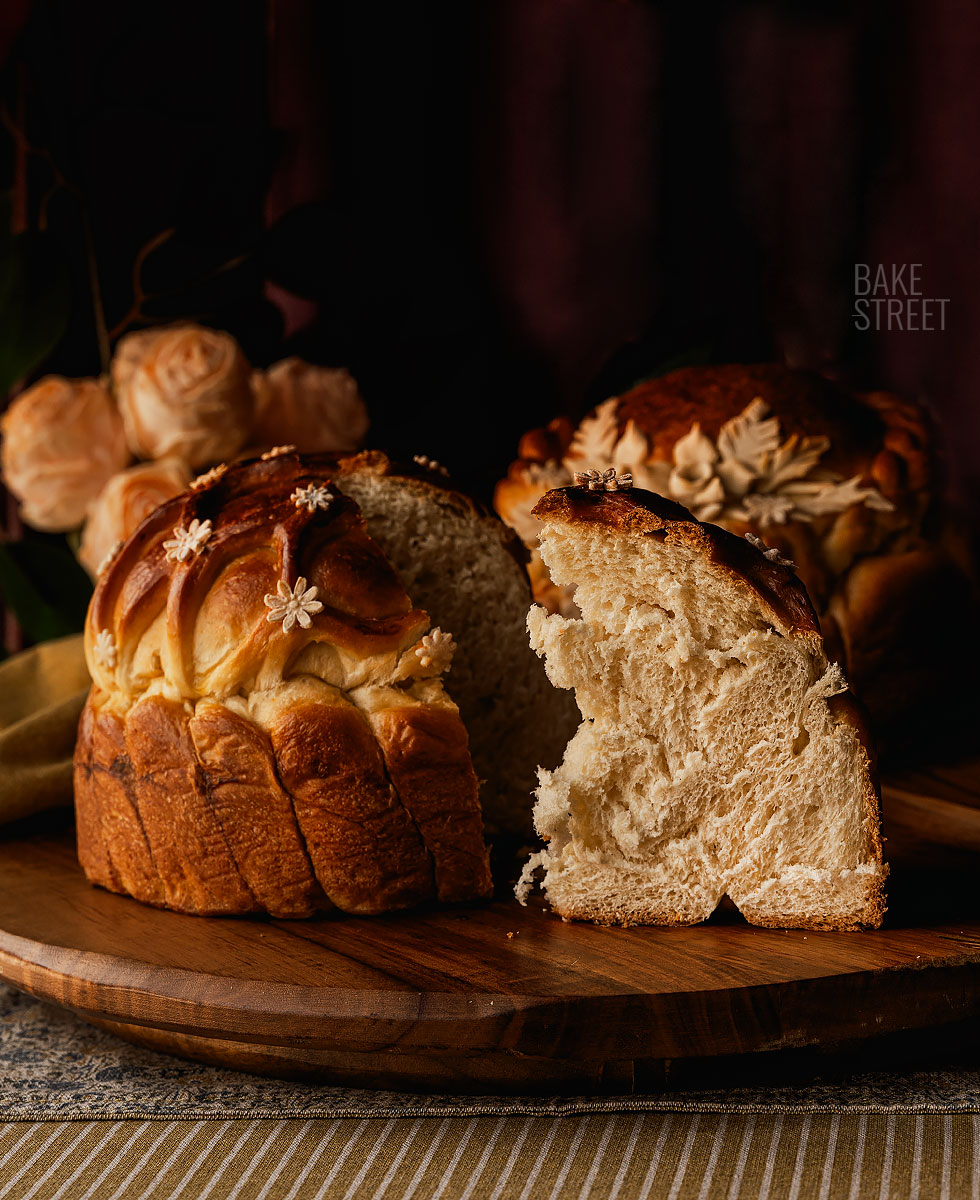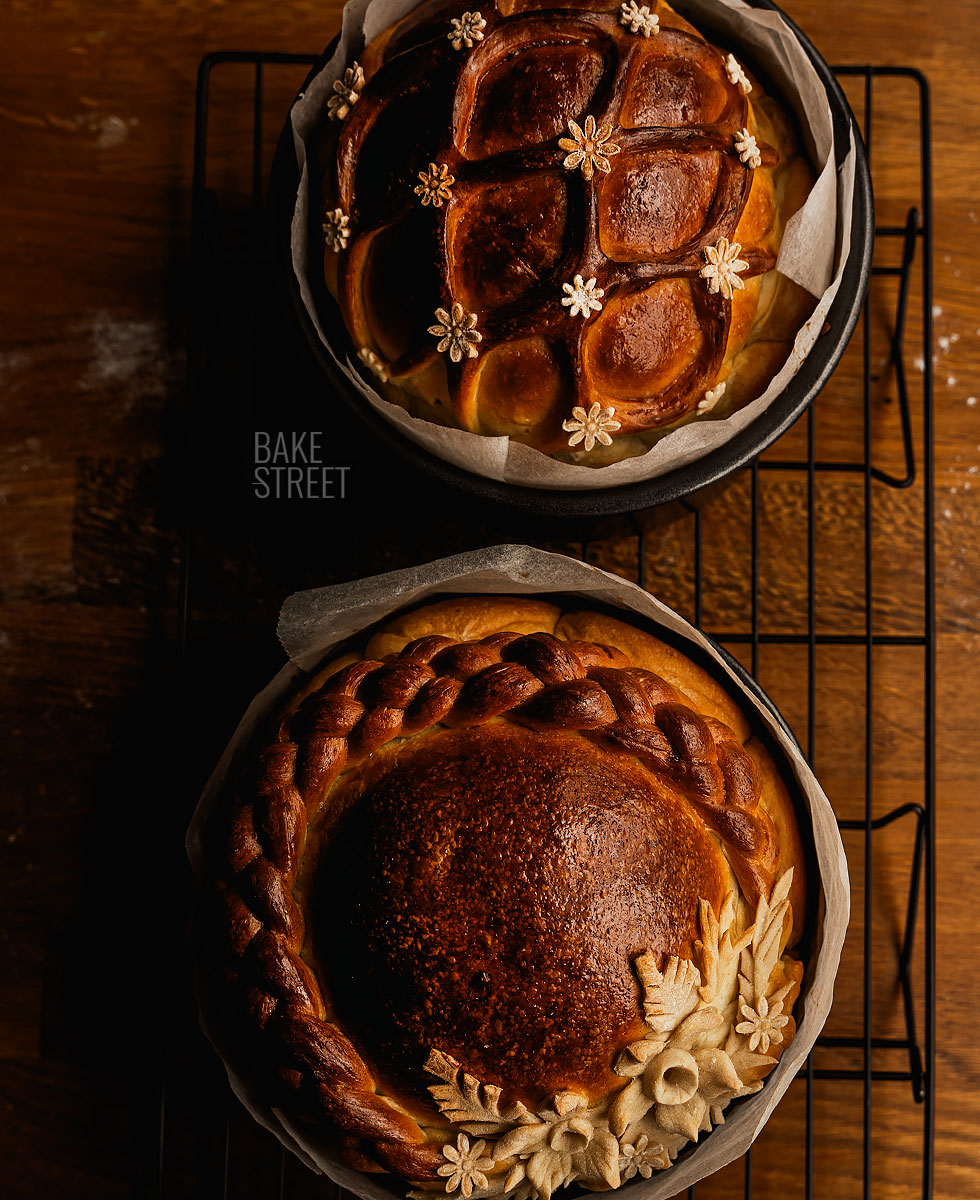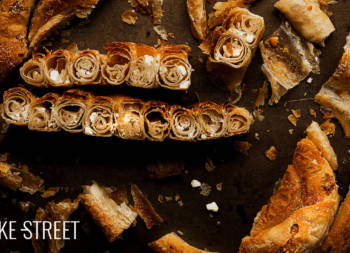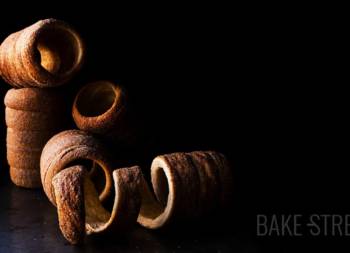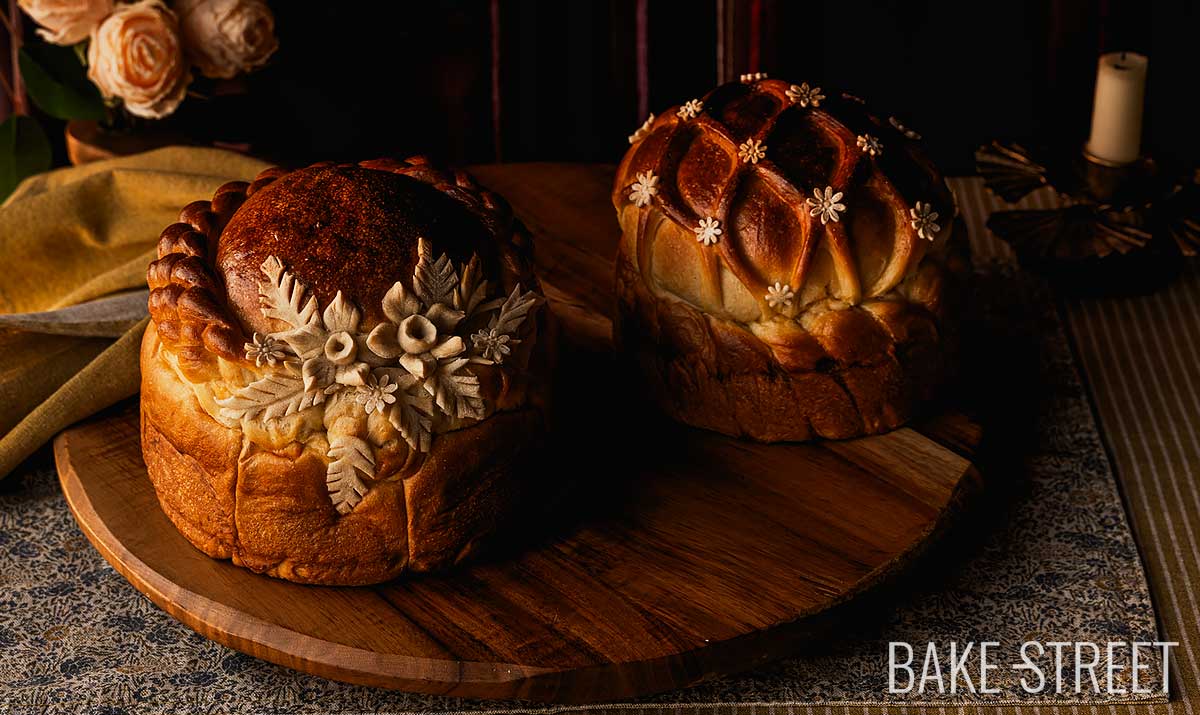
Slavski Kolač – Serbian ceremonial Slava bread
It’s been a long time since I’ve left you dough recipes, and I’ve really missed them. It’s strange because, really, I could make them more often. But I’m a restless soul and I love to make, create and try different recipes from all over the world, which sometimes leads me to postpone amazing creations like this one. Today I want to share with you how to make Slavski kolač – Serbian ceremonial Slava bread.
I have been saving recipes for this and similar sweet breads for about two years now, but I’m not going to tell you something you already know…. Always have recipes piling up, for one reason or another. I didn’t know how much I missed working with these doughs until I started working with it. For me, any work done with our hands transmits energy, whether it is painting, music, writing, carpentry or, in this case, cooking.
Personally, I find my space of peace when I am cooking.
It is the only place where I “disconnect from reality” and experience a dimension where I am really me. I can express myself, I can transmit my thoughts and emotions to what I am doing, without forgetting that the concept of time disappears completely. How important it is to find something that allows us to live like this.
For that reason, I have always thought and always will, that the magic ingredient in recipes comes from the person who makes them. Many times we eat something that our mother, grandmother or someone else has prepared, but when we make it ourselves, it doesn’t taste the same. Not even using the same quantities, ingredients or time. That essence cannot be seen nor can it be bought. That quality can only come from one person while carrying out the recipe. Little by little, seeing how the ingredients are transformed, participating in the process, transmits that love that gives soul to the elaboration.
I believe that this can be extended to anything we do in life. That is why we can appreciate differences in things. We perceive the energy that each person transmits to what they do and, best of all, we manage to make it become part of them. The magic of the human being.
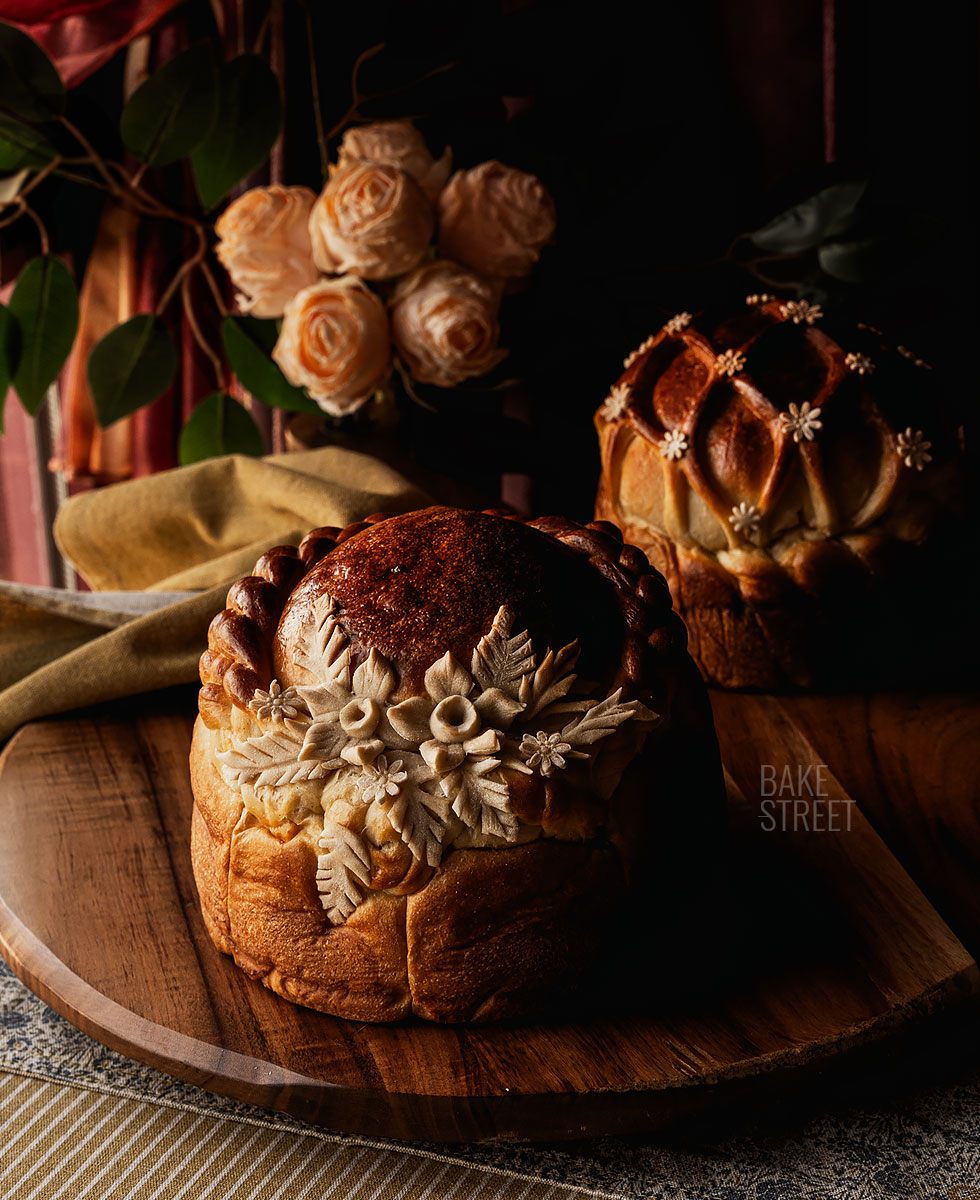
Origin and significance of the Slavski kolač in Orthodox celebrations.
The recipe I bring you here is not only visually appealing, but the result is a wonderful sweet bread with a soft and delicate texture, full of sweet and citrusy aromas.
Slavski Kolač is a type of traditional Serbian bread made especially for the celebration of Slava, a Christian Orthodox religious holiday marking the veneration of the family’s patron saint. This holiday is unique to Serbian Orthodox families and is celebrated annually. Slavski kolač is a fundamental part of this celebration and is considered a symbol of prosperity and blessing for the family.
The importance of slavski kolač in the celebration of Slava shows the interconnectedness of religion, culture and gastronomy in the everyday life of Serbian Orthodox communities.
The shape of the bread is usually round and its peculiarity is its decoration. This is carried out by means of craftsmanship that takes shape thanks to the imagination of the person who makes it. It is often decorated with religious or family symbols.
The making of this Slavic bread is a traditional process that is passed down from generation to generation in many Serbian families, forming part of their cultural and religious heritage. The exact ingredients and techniques may vary according to region and family preferences, but typically involve flour, yeast, salt, sugar and is often flavoured with citrus fruits.
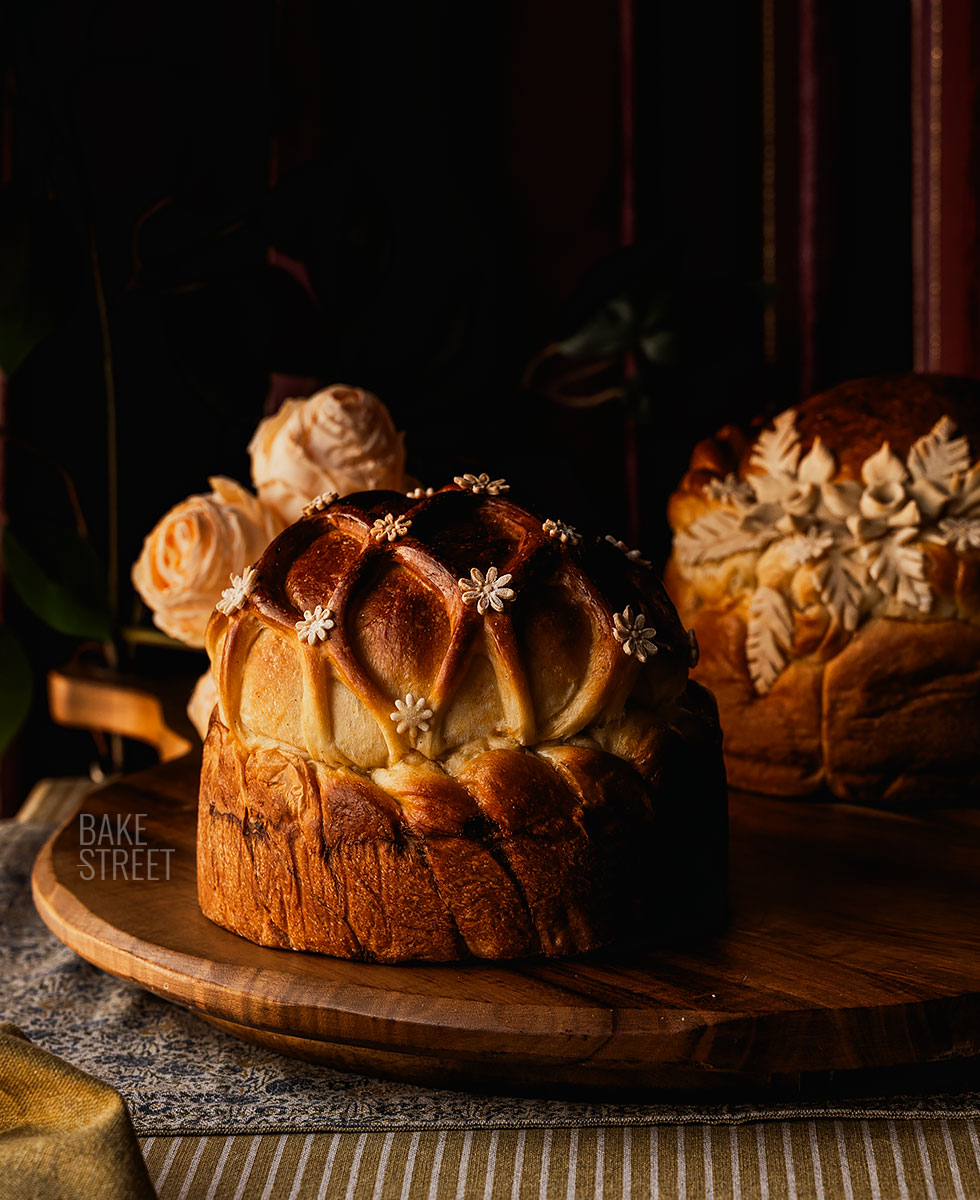
Slava’s celebration.
This is a unique religious and cultural holiday in the tradition of the Serbian Orthodox Church. It is a family celebration that honours the family’s patron saint, who is considered a protector and spiritual guide. Each Serbian Orthodox family has its own patron saint, and the Slava celebration focuses on honouring that particular saint.
The Slava festivity usually begins with a visit to the church for special religious services dedicated to the family’s patron saint. After church, family and friends gather at the hosts’ home to enjoy a festive meal. Typical Slava food includes a wide variety of traditional Serbian dishes and, of course, the special bread called slavski kolač, which is an indispensable part of the celebration.
Each Slava is unique to each family and is celebrated with great reverence and joy.
During the Slava celebration, specific rituals are performed, including the blessing of bread and wine, as well as the lighting ceremony of a special candle called “slavska sveć“. The holiday also involves sharing family stories and traditions, strengthening family ties and passing on cultural heritage from generation to generation.
Undoubtedly, it is an integral part of Serbian identity and culture. It is an important occasion to bring family, friends and community together around shared faith and traditions.
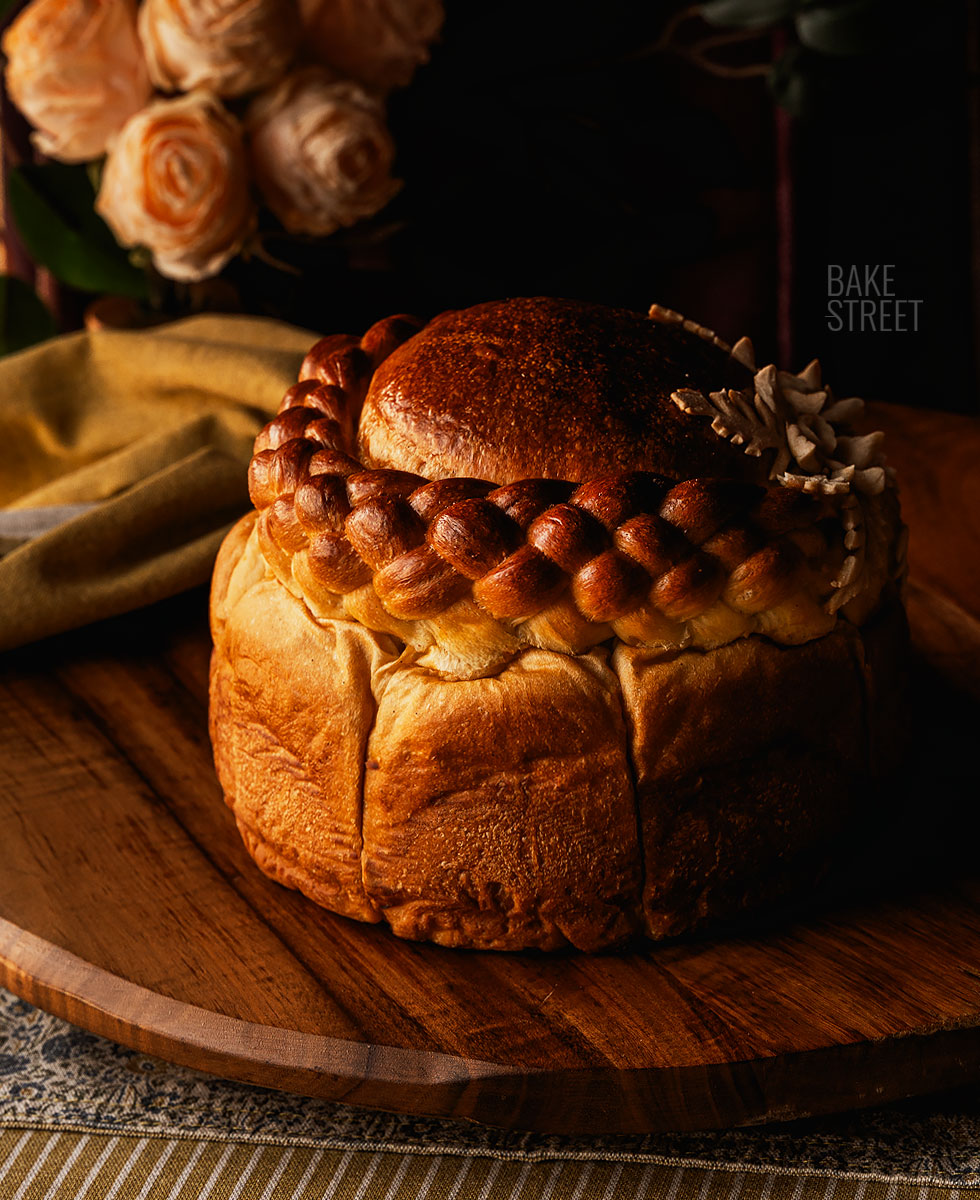
When does Slava take place?
The celebration of Slava takes place on a specific day of the year, and this day corresponds to the day of the family’s patron saint. Each Serbian Orthodox family has its own patron saint, and the date of the Slava is based on the liturgical calendar of the Orthodox Church.
Most Slavas are celebrated on a fixed day of the Julian calendar, which is different from the Gregorian calendar used in most Western countries. This means that the dates of Slavas may vary compared to the Gregorian calendar, and some Slavas may coincide with important Orthodox holidays, while others may not.
For example, if the family’s patron saint is St. Nicholas, whose feast day in the Gregorian calendar falls on 6 December, then that family’s Slava would be celebrated on 19 December in the Julian calendar.
There are other similar elaborations.
Pasca, pogača, colac moldovenesc and Korovai have a certain similarity in appearance and tradition to slavski kolač. They all share ingredients, traditions and qualities handed down from generation to generation, but differences can be found between them.
Pasca.
A traditional type of sweet bread eaten during Easter in Orthodox communities, including those in Serbia. A sweet, enriched dough often made with simple ingredients such as eggs, butter, milk, sugar and sultanas. It is usually round or rectangular in shape and may be decorated with crosses or other religious symbols. Traditionally eaten during Easter celebrations and is an important part of the Orthodox culinary tradition. Some time ago I left you this recipe for Pasca.
Pogača.
Typically, it is a variety of flat, round bread found in several countries in Eastern Europe and the Balkans, including Serbia. There are many variants of pogača, some are fluffier and softer, while others are denser and crispier. They can be made with different ingredients and are served on a variety of occasions, from everyday meals to festive events. Pogača does not necessarily have a specific connection with a religious holiday such as pasca or slavski kolač.
Colac moldovenesc.
A traditional sweet bread variety from Moldova, a region located in south-eastern Europe, on the border between Romania and Ukraine. This bread is similar to Serbian ‘slavski kolač‘ in terms of its festive and decorative nature, but differs in shape and some variations in specific ingredients and decorations.
A sweet and fluffy dough that may include ingredients such as eggs, milk, butter, sugar, sultanas, nuts or candied fruit. It is often flavoured with vanilla, lemon zest or spices such as cinnamon and formed into a twisted loaf. Like ‘slavski kolač‘, ‘colac moldovenesc‘ is made especially for festive occasions and family celebrations, such as weddings, christenings, Christmas or Easter.
It has not only decorative value, but can also have symbolic meanings related to family unity and community. Like many traditional breads, colac moldovenesc is a symbol of abundance, prosperity and good intentions for those who make and share it. Here you can find the recipe to make it.
Korovai.
It is a traditional sweet bread preparation originating in Ukraine and is similar in certain respects to the sweet breads mentioned above, such as pasca, slavski kolač and colac moldovenesc. Although they have their regional and cultural differences, they share some similarities in terms of their cultural significance, their association with festive celebrations and rituals, and their production as a culinary art form. Korovai, like pasca, slavski kolač and colac moldovenesc, is made especially for festive and ceremonial occasions, such as weddings, christenings and other important celebrations. It is a symbol of abundance, prosperity and good fortune in Ukrainian culture, and is often elaborately decorated with traditional interlacing designs, figures and symbols. Some are true jewels of craftsmanship.
In addition, like the pasca and the slavski kolač, the korovai has symbolic and ritualistic significance in many celebrations. For example, in Ukrainian weddings, the korovai is one of the central elements of the wedding ceremony and is exchanged between the bride and groom as a symbol of union and prosperity.
Slavski kolač.
It is a special bread made specifically for the celebration of Slava, a Serbian Orthodox religious holiday marking the veneration of the family’s patron saint. Unlike pasca, which is specific to Easter, and pogača, which is a general type of bread, slavski kolač is directly associated with this Serbian religious holiday. The bread is usually round, elaborately decorated and considered a symbol of prosperity and blessings for the family during the Slava celebration.
We have seen that all of the above sweet breads, although they come from different regions and cultures, are all elaborations that share a common link in their role; to enrich and celebrate important events in people’s lives.
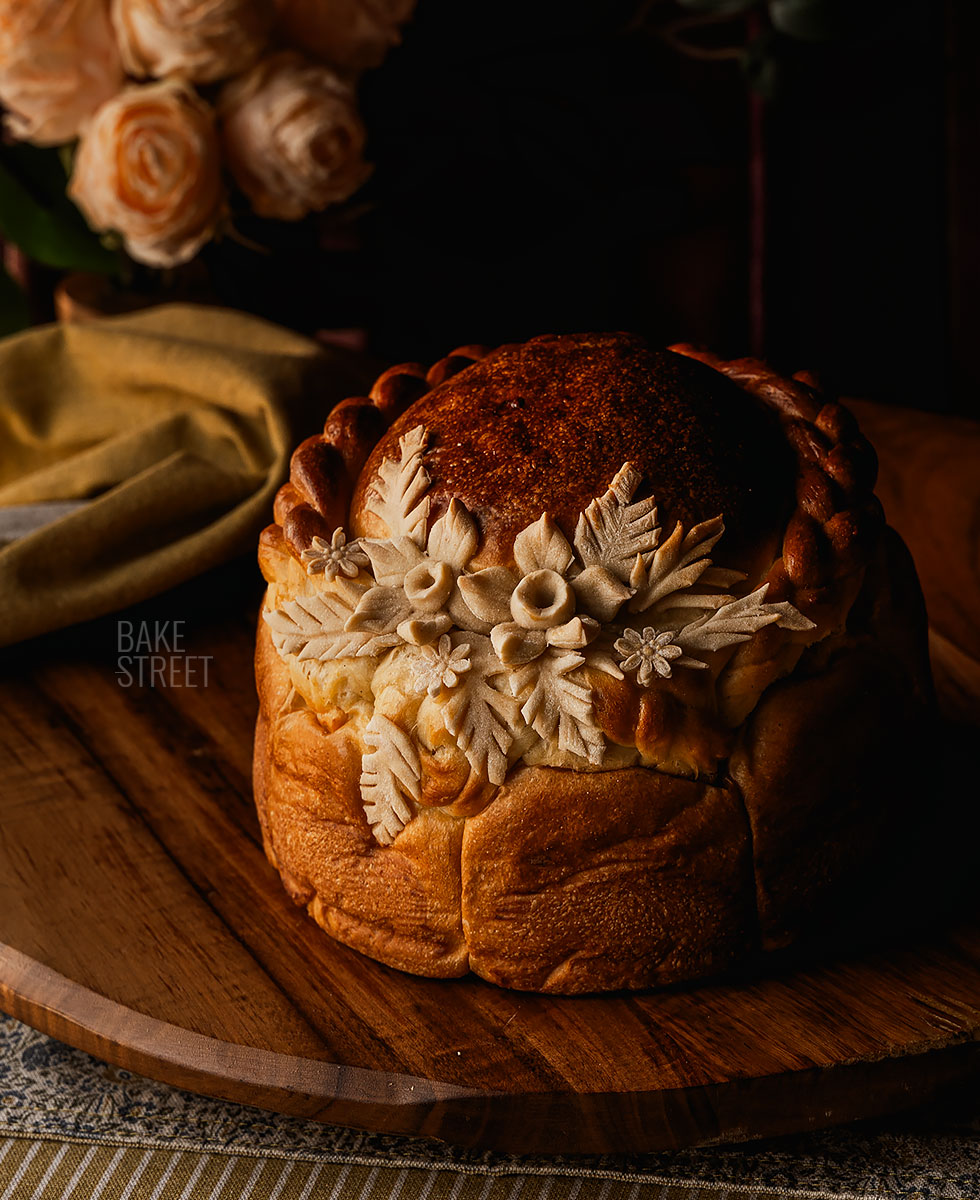
Authentic Slavski kolač decoration with religious motifs.
Traditionally, these breads are decorated with white dough and their designs include crosses, doves, flowers and squares that often include an inscription ‘krst‘ (cross), other inscriptions or religious symbols around the square. These inscriptions can include words or phrases such as “ХВ” (Христос Воскресе, “Christ is risen”) or “СХ” (Срећна слава, “Happy Slava”).
In my case I leave you some simpler and less religious elaborations, as I do not have these markers.
Recipe Slavski Kolač - Serbian ceremonial Slava bread
DOUGH:
- 825 g flour T45 or flour W=280-290 (maybe bread flour)
- 245 g whole milk
- 15 g fresh yeast or 5 g dry yeast
- 80 g sugar
- 75 g unsalted butter, room temperature
- 55 g olive oil
- 225 g egg (about 4 L eggs)
- 15 g rum
- grated zest of one orange and one lemon
- 1 teaspoon, generous, vanilla extract
- 12 g salt
WHITE DOUGH:
- 235 g AP flour
- 110-120 g water
- 3 g salt
FOR BRUSING:
- 1 egg+ 1 Tbsp whole milk
MATERIAL WE WILL NEED AND VISIBLE IN THE VIDEO:
- kneader
- container/large bowl (litre 6 capacity)
- scraper
- rolling pin
- round mould 15 cm diameter
- round mould 18 cm diameter
- scraper
- flower cutters with and without ejector
- lattice roller pin
- sharp knife
- pastry brush
- cooling rack
Instructions
FIRST DAY
Make dough.
- In the bowl of the kneader add the flour together with the eggs, milk and half of the sugar. Knead on low speed for 2 minutes. Add the other half of the sugar and knead for a further 2 minutes. You will obtain an amalgamated dough.
- Add the yeast and knead again for 2 minutes.
- Add the citrus zest, rum and vanilla, knead until evenly distributed.
- Stop the kneader and start adding the butter little by little. Allow the butter to fully integrate into the dough before adding more. During the whole process of incorporating the butter, knead on medium speed.
- Add the salt and mix until it is distributed throughout the dough.
- Pour the oil, in two batches, and wait to add the next batch until the first batch is fully integrated. You will notice that the consistency of the dough becomes soft, smooth and with a lovely gluten development.
- Leave to rest in the bowl, covered with film or plastic wrap, for 25 minutes.
- Take out the dough, fold it and put it into a bowl, previously greased with olive oil.
- Leave at room temperature for 1 hour, in my case at 69ºF/20ºC.
- Keep in the fridge for 12-24 hours. In my case it was 21 hours at 39.2ºF/4ºC.
- NOTE: When using containers of different proportions, it is difficult to know what volume the dough acquires. I advise you to take a small portion and put it into a shot glass. That way you will know exactly how much the dough has grown. The dough should quadruple in volume.
SECOND DAY
Prepare white dough for decoration.
- In a bowl, mix the flour with the water and salt. In my case I didn't add all the flour at once, I left a small amount reserved to achieve an amalgamated and developed dough and, in that way, favour the development of the gluten.
- Once you have a homogeneous dough, add the rest of the flour (I reserved about 30 g of flour).
- Turn out onto a clean work surface and knead. You should knead until you have a smooth, even and very soft finish.
- Cover with cling film and leave the dough to rest for 2 hours. This step will allow the gluten to relax and you will be able to work the dough later without any problems.
Form the bread with a lattice top.
- Line two round moulds, with the specified or similar measurements.
- To form the loaves, work with the dough straight out of the refrigerator.
- Turn the dough out onto a work surface and degas. Join the small piece of dought to the larger one.
- Cut out two pieces of approximately 115 g. These will be used to form two strands of approximately 70-75 cm.
- Braid as shown in the video.
- Place inside the 15 cm diameter mould, cut off the excess braid and seal the union of the two ends. I recommend that you don't cut the braid just right, leave a little extra so that it doesn't separate.
- Cut a piece of 230 g and make a ball to form a round piece.
- Cut a piece of approximately 110 g to create the upper lattice. Roll out on a floured surface to a thickness of about 0.3 cm.
- Using a lattice rolling pin, forcefully mark out the dough. It is possible that not all the cuts will be made. This tool is a marker, not a cutter, so you will have to use a knife to open the grooves that are only marked.
- Gently roll out and place on the round piece. Cut off the excess dough and tuck part of the lattice under the piece so that it stays in position during rising and baking.
- Place inside the braid so that this round piece is surrounded by the two-strand braid.
- Cover with cling film and leave to rise for the final fermentation.

Form the bread with the 5-strand braid on the surface.
- Form 8 balls of 36 g each. Gently roll each piece and place inside the 18 cm diameter mould.
- Shape and roll a 290 g piece, place in the middle of the mould so that it is surrounded by the 8 small pieces of dough.
- Cut 5 strips and give a length of approximately 50 cm. Roll on the work surface to form a cord shape. If necessary, seal joints in the cord so that it remains smooth.
- Form a 5-strand braid as shown in the video.
- Place the braid around the round piece. If you wish, you can decorate the join of the two ends of the 5-strand braid with a 3-strand braid. In my case I wrapped the joint with it.
- Cover with cling film and leave to ferment.
- NOTE: Both pieces spent 3 hours at 70ºF/21ºC doing the final fermentation. The pieces should almost triple in volume. With the excess dough, I formed 4 pieces of 100 g each and placed them in individual brioche moulds.

Form the decorations with white dough.
- While the pieces are undergoing the final fermentation, form the decorations. In this step, let your imagination run wild.
- In my case, I formed small flowers for the bread with the lattice and larger flowers, along with leaves, for the piece with the five-strand braid.
- To cut the pieces with the ejector cutters, I recommend flouring the mould beforehand so that the dough does not stick to it, as the flower or decoration will be deformed.
- NOTE: At first I had planned to make more decorations with white dough, but in the end I decided to overload the pieces less. By this I mean that if you make half the amount of dough that I have listed in the ingredients, it will be more than enough.
Bake.
- Preheat the oven to 338ºF/170ºC, heat up and down.
- Brush the pieces with egg beaten with milk.
- Carefully place the decorations on the breads.
- Bake, placing the baking tins on the second rack starting from the bottom. The 15 cm bread baked for 35 minutes and the 18 cm bread for 45 minutes. When you have baked for 20-22 minutes, I recommend covering the breads with aluminium foil to prevent them from browning too much.
- Remove, leave to rest for 5 minutes in the tin, unmould and leave to cool completely on a wire rack.
- NOTE: I baked the small 100 g pieces in the brioche moulds for 17 minutes. Remember that the internal temperature of each piece, large and small, must reach 190º-194ºF/88º-90ºC for the baking to be finished. I recommend that you check the internal temperature, so that you avoid overcooking the bread and leaving it dry.

Notes
- If you cannot find T45 flour, you can use a flour W=280-290 approximately, maybe bread flour, as a substitute. It is important to observe how the flour behaves as you add ingredients to see if it has sufficient absorption capacity. If you do not know the flour you are going to work with, add the milk little by little.
- If you don't want to use rum, you can omit it and replace that part with milk.
- You must be patient in the kneading process to obtain a good result in the development of the dough.
- You should work on forming the breads with the dough cold. This will facilitate the handling of the dough, especially the shaping.

- Respect all the steps, resting and rising times to obtain a good result in terms of flavour, texture and sponginess.
- I used brioche moulds with a diameter of 10 cm for the 100 g pieces.
- The white dough is very easy to shape. You can either use cutters or shape the pieces by hand.

- The white dough is very hard after baking. In my humble opinion, I think that their purpose is merely decorative and they should not be consumed.
- They will keep in perfect condition for 4-5 days if kept in a zip bag at room temperature or wrapped in plastic wrap.

It has been a long time since I have enjoyed baking a sweet bread so much, Slavski kolač - Serbian ceremonial Slava bread has been a wonderful discovery for me and, I hope and pray, for you too. In case you don't know it, of course.
The bread is incredibly tender, delicate, full of wonderful sweet aromas. So much so that even when they were wrapped in film on the kitchen table, they gave off an aroma. That extended all the way to the entrance of the house. Wonderful is not enough, I promise you.
Of course, if you find the decoration, in any of the cases, complex or laborious, you can always simplify it, but remember to adjust the baking times to the final size of the dough that you have in the mould/s.
By the way, I remind you that you can watch all my videos on my YouTube channel. If you subscribe and turn on the little bell, I will be eternally grateful!
I wish you a wonderful Sunday afternoon!
Lots of love,
Eva



